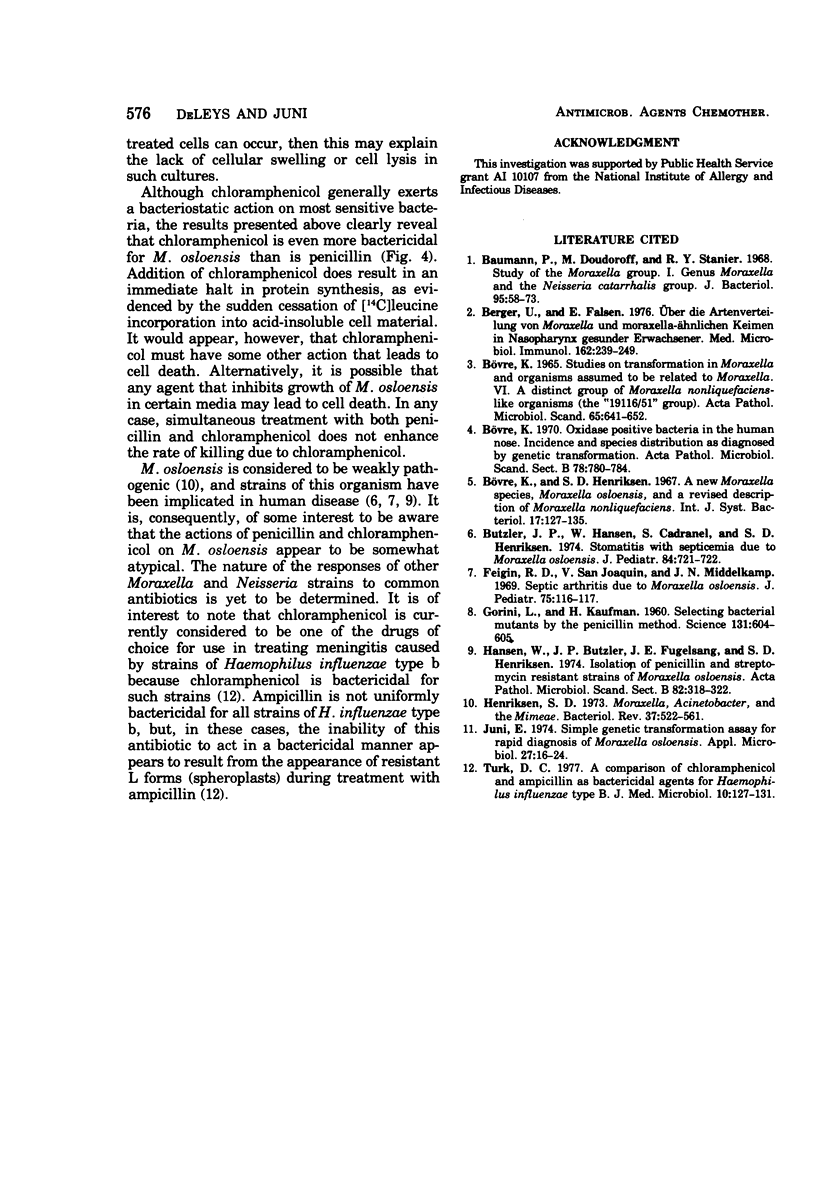Abstract
Growth of exponential-phase liquid cultures of Moraxella osloensis was inhibited by 0.5 U of penicillin G per ml. For this organism, low concentrations of penicillin acted primarily in a bacteriostatic rather than in a bactericidal manner. At higher concentrations of penicillin some killing did take place, but the rate of killing was rather slow and appeared to be independent of penicillin concentration. Microscopic observation of cells from penicillin-treated cultures showed little or no cellular swelling or lysis. The total cell count did not decrease significantly during 6 h of incubation in 5,000 U of penicillin per ml. The rates of respiration, nucleic acid synthesis, and protein synthesis were not affected by the presence of penicillin. Attempts to counteract the bactericidal action of high concentrations of penicillin with growth inhibitory concentrations of chloramphenicol were unsuccessful, since chloramphenicol itself was more bactericidal than penicillin for M. osloensis.
Full text
PDF



Selected References
These references are in PubMed. This may not be the complete list of references from this article.
- Baumann P., Doudoroff M., Stanier R. Y. Study of the Moraxella group. I. Genus Moraxella and the Neisseria catarrhalis group. J Bacteriol. 1968 Jan;95(1):58–73. doi: 10.1128/jb.95.1.58-73.1968. [DOI] [PMC free article] [PubMed] [Google Scholar]
- Berger U., Falsen E. Uber die Artenverteilung von Moraxella und moraxella-ähnlichen Keimen im Nasopharynx gesunder Erwachsener. Med Microbiol Immunol. 1976 Dec 1;162(3-4):239–249. doi: 10.1007/BF02121002. [DOI] [PubMed] [Google Scholar]
- Bovre K. Oxidase positive bacteria in the human nose incidence and species distribution, as diagnosed by genetic transformation. Acta Pathol Microbiol Scand B Microbiol Immunol. 1970;78(6):780–784. [PubMed] [Google Scholar]
- Butzler J. P., Hansen W., Cadranel S., Henriksen S. D. Stomatitis with septicemia due to Moraxella osloensis. J Pediatr. 1974 May;84(5):721–722. doi: 10.1016/s0022-3476(74)80016-8. [DOI] [PubMed] [Google Scholar]
- Feigin R. D., San Joaquin V., Middelkamp J. N. Septic arthritis due to Moraxella osloensis. J Pediatr. 1969 Jul;75(1):116–117. doi: 10.1016/s0022-3476(69)80109-5. [DOI] [PubMed] [Google Scholar]
- GORINI L., KAUFMAN H. Selecting bacterial mutants by the penicillin method. Science. 1960 Feb 26;131(3400):604–605. doi: 10.1126/science.131.3400.604. [DOI] [PubMed] [Google Scholar]
- Hansen W., Butzler J. P., Fuglesang J. E., Henriksen S. D. Isolation of penicillin and streptomycin resistant strains of Moraxella osloensis. Acta Pathol Microbiol Scand B Microbiol Immunol. 1974 Jun;82(3):318–322. doi: 10.1111/j.1699-0463.1974.tb02333.x. [DOI] [PubMed] [Google Scholar]
- Henriksen S. D. Moraxella, Acinetobacter, and the Mimeae. Bacteriol Rev. 1973 Dec;37(4):522–561. doi: 10.1128/br.37.4.522-561.1973. [DOI] [PMC free article] [PubMed] [Google Scholar]
- Juni E. Simple genetic transformation assay for rapid diagnosis of Moraxella osloensis. Appl Microbiol. 1974 Jan;27(1):16–24. doi: 10.1128/am.27.1.16-24.1974. [DOI] [PMC free article] [PubMed] [Google Scholar]
- Turk D. C. A comparison of chloramphenicol and ampicillin as bactericidal agents for Haemophilus influenzae type B. J Med Microbiol. 1977 Feb;10(1):127–131. doi: 10.1099/00222615-10-1-127. [DOI] [PubMed] [Google Scholar]


